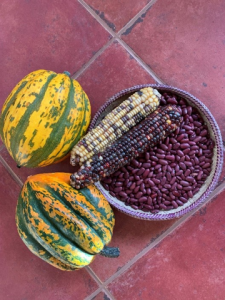Chapter 7 – Three Sisters
The term ‘Three Sisters’ refers to corn (Zea mays), beans (Phaseolus vulgaris), and squash (Cucurbita spp.) grown together in an ancient Indigenous American companion planting scheme.  Each crop complements the others so that growing the plants together provides greater benefits than planting them as single crops. The harvested products are also complementary in a nutritional sense, with the corn providing carbohydrates, the beans furnishing protein, and the squash adding vitamins to the diet.
Each crop complements the others so that growing the plants together provides greater benefits than planting them as single crops. The harvested products are also complementary in a nutritional sense, with the corn providing carbohydrates, the beans furnishing protein, and the squash adding vitamins to the diet.
Harvested Three Sisters crops are represented by squash, corn and beans. (Photo credit: Pat Byrne)
Three Sisters agriculture was historically developed and practiced by diverse tribes throughout North America. Our team acknowledges, with respect, that this practice has survived thanks to those who persisted in the face of adversity. We sincerely thank all who continue to keep this tradition alive, and encourage you to learn from them.
Additional resources on Three Sisters agriculture can be found in chapter 9 of this eBook.
video
This video explains what each member of the triad brings to the partnership, and recounts some of the history and distribution of the practice. The Three Sisters are not only of historical interest, but they also provide lessons that are relevant to the sustainability of our current cropping systems.
review
Click through these interactive questions to review the important concepts that were discussed in this chapter.
